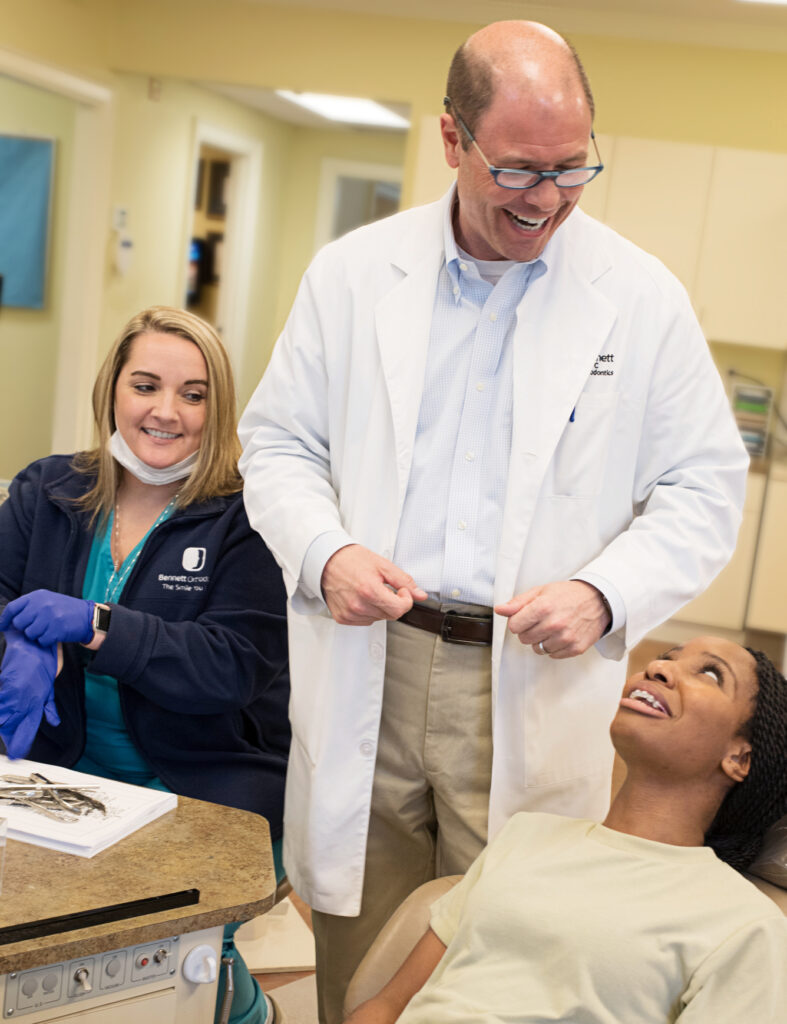Achieving the alignment of your dreams is more than waiting for your orthodontic devices (braces, clear aligners, etc.) to work their magic. It’s a group effort by your appliances, Dr. Bennett, his team, and you! That’s right — we can’t do it without you! The first big step is attending your first orthodontic appointment, but your role in your care doesn’t stop there! We also need you to maintain good oral health during treatment. If that sounds challenging or you don’t know where to start, don’t worry. That’s what we at Bennett Orthodontics are here for! Below are some of our top tips for supporting oral health during orthodontic treatment.
Maintain Your Oral Hygiene.
If you went to the dentist growing up, you have probably heard the importance of developing good oral hygiene practices. When you are in treatment, your routine does not lose relevance points just because an orthodontic appliance covers your teeth. In fact, some might argue that it’s more important than ever to maintain your oral hygiene routine.
Brushing and flossing twice a day is an easy, quick way to reduce the amount of bacteria, plaque, and germs in the mouth that can cause tooth decay, bath breath, and gum disease. We recommend an automatic toothbrush with a pressure sensor and timer to easily avoid over- or under-brushing that can leave behind residue, strip the teeth of their protective enamel, or push down the gum line. We also recommend wax floss because slipping it between teeth and orthodontic appliances requires less effort than unwaxed floss.
Attend Your Dental Appointments!
Dentists are excellent oral healthcare providers! We encourage you to attend your dental cleanings/check-ups as often as your dentist says is necessary (usually once or twice a year) for improved oral health. At these appointments, your teeth will be X-rayed, professionally cleaned, fluoride applied, and examined by a dentist.
Attending these appointments consistently every year allows your oral healthcare team to catch problems like cavities, gum disease, infections, and oral cancer. If necessary, they’ll administer treatment before the issue can cause permanent problems.
Your teeth and gums must be healthy before and during treatment for a pain-free experience and beautiful results. When treatment ends, we encourage you to continue seeing your dentist to maintain your smile’s health and appearance.
Pick The Right Mouthwash And Toothpaste.
The best mouthwash and toothpaste depend on your specific needs, and we are always delighted to provide personalized recommendations at your appointments. However, most, if not all, orthodontic patients should look for the following:
- Not too harsh! — Whether you have braces or wear removable clear aligners, you don’t want your cleaning products to be too acidic! Acid can cause staining and rust.
- Fluoride needed! — Fluoride is a chemical found naturally in the environment that strengthens your enamel and helps to protect the teeth. Be sure to ask your oral healthcare providers before you add fluoride to your daily routine. They might suggest fluoride use less frequently.
- Non-whitening! — White teeth are trendy, and we agree they are beautiful, but when you have bonded appliances, you want to avoid whitening products. Because your appliances cover parts of your teeth, the whitening products won’t touch some areas. It might look nice during treatment, but your teeth will be in multiple colors when your devices are removed! It can be a long, frustrating process to make them the same uniform color again, so we must stress the importance of waiting until after treatment ends to begin the whitening process.
Eat With Your Treatment In Mind.
Bonded appliances mean you have to adjust your eating habits to accommodate all the metal in your mouth. Certain foods and drinks can damage your appliances by breaking brackets or warping wires. This can create unnecessary pain or alter your teeth’s movement in an undesired way.
If you have clear aligners or braces, you should try to avoid food and drink that can stain your teeth and therefore stain your aligners. If you do eat those foods, you should rinse your mouth with water after meals.
To help make adjusting your diet less stressful, we’ve put together this list of foods and drinks to look out for.
- No crunchiness! — Crunchy foods like popcorn, chips, hard taco shells, and nuts can be too hard on the braces.
- No hard or sticky food. — Food that is hard, like ice, can damage the braces. Sticky food, like caramel or gum, can get stuck on your braces and be difficult to remove. If the food or candy is both hard and sticky, it can be very inconvenient and potentially harmful for you and your braces.
- Avoid Fibrous vegetables or “bite into” fruit — Fibrous vegetables like celery are often full of string that can get stuck in your orthodontic work. Apples and other hard fruits that you bite into can damage the front brackets. Some fibrous vegetables like broccoli and carrots are also too rough on braces. We recommend cutting them into smaller pieces when eating.
- No Sugary and Acidic Drinks — Beverages, including but not limited to sodas, sports drinks, and energy drinks, have a lot of sugar and are high in acid that can damage your metalwork and your teeth — with or without braces!
Food and drink that are bad for the teeth can also cause tooth decay and other oral health complications that can be painful and affect your orthodontic treatment. Dr. Bennett can provide a more extensive list upon request, and don’t ever hesitate to ask him if a specific food or drink is safe for consumption.
Water Flossers Are Game Changers.
Whether you are an orthodontic patient or not, we strongly encourage you to add a water flosser to your routine. These machines use jets of water to remove stubborn bacteria and plaque from your teeth and gums. The “water jet” is also able to reach and clean every nook and cranny of your mouth and orthodontic appliance! They can clean your mouth’s hard-to-reach places of any food left behind by brushing and flossing. Water flossers also ward off bad breath and diseases caused by a build-up of plaque or germs. It is important to note that this should be done in addition to waxed flossing and not be used as a replacement!
 With Bennett Orthodontics, Oral Health Doesn’t Have To Be Overwhelming.
With Bennett Orthodontics, Oral Health Doesn’t Have To Be Overwhelming.
Bennett Orthodontics has all the answers you need to confidently, comfortably, and safely navigate your oral health during treatment. We know that changes to your lifestyle and routine can be challenging, and knowing what is safe or not safe can be confusing, but we take pride in your experience being as easy and non-disruptive to your lifestyle as possible.
To learn more about the treatment options we provide or our team, contact us today to schedule a free consultation! We would love to answer all your questions and discuss what orthodontic work can do for you!
Our entire team looks forward to meeting you soon!
 With Bennett Orthodontics, Oral Health Doesn’t Have To Be Overwhelming.
With Bennett Orthodontics, Oral Health Doesn’t Have To Be Overwhelming.
